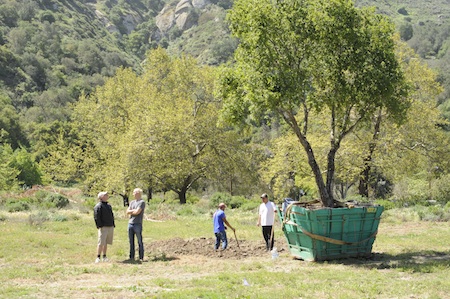
With the removal of invasive exotic plants and their replacement with native plants and oak trees, the first phase of a five-year habitat restoration project at Laguna Canyon’s Big Bend is completed, the Laguna Canyon Foundation announced Tuesday.
The project, partially funded by a grant from the Orange County Transportation Authority, will restore a weedy lot to a meadow of native plants with public trails and picnicking areas, according to Max Borella, executive director of the foundation, created to preserve and enhance the Laguna Coast Wilderness Park and surrounding parklands.
“I have always considered the majestic cliffs of Big Bend to be the city entrance. Nothing welcomes us home quite like the sight of that soaring ridgeline,” Borella said. “Laguna Canyon Foundation purchased the ridgline property in partnership with the city of Laguna Beach and the Conservation Fund, and we are proud to continue our work by transforming the city-owned field below to native habitat.”
The foundation won an OCTA grant to restore the 3.7-acre field to a passive nature area in 2012. For four previous years, the area served as a holding yard for four historic cottages stuck in limbo, relocated to Big Bend from downtown in expectation of a rescuer. When no one surfaced, they were deconstructed to allow for the establishment of a new trailhead and wildlife corridor in Laguna Canyon in the former weed filled lot.
The nature area was designed by local landscape architect Richard Ramsey and foundation President Derek Ostensen, who is also managing the restoration project.
The first step of the project included retention of some of the larger non-native trees, kept as “heritage” trees, Ostensen said. The new plants will be irrigated for an initial two-year period until the roots establish, and then will rely on natural rainfall, he said. The final phase of the habitat restoration project will include the construction of a public trail and seating areas.
“The project will grow more beautiful each week as the vegetation fills in and will be a vital resource for a number of sensitive flora and fauna which inhabit the site and surrounding open space,” said Ostensen.
More than 5,000 native wildflowers, plants and trees have been restored to the site, with additional species planned for next season, he said. Together, this native habitat will support a wide range of wildlife, including butterflies, raptors, deer and bobcat, he said. A number of important species also use the site as a connection point between Laguna Coast and Aliso and Wood Canyons Wilderness Parks.
Photo by Joe Mozdzen




